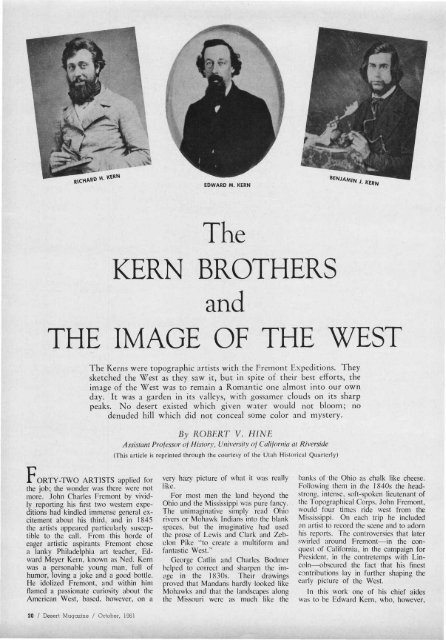OUTDOOR SOUTHWEST - Desert Magazine of the Southwest
OUTDOOR SOUTHWEST - Desert Magazine of the Southwest
OUTDOOR SOUTHWEST - Desert Magazine of the Southwest
Create successful ePaper yourself
Turn your PDF publications into a flip-book with our unique Google optimized e-Paper software.
EDWARD M. KERN<br />
The<br />
KERN BROTHERS<br />
and<br />
THE IMAGE OF THE WEST<br />
The Kerns were topographic artists with <strong>the</strong> Fremont Expeditions. They<br />
sketched <strong>the</strong> West as <strong>the</strong>y saw it, but in spite <strong>of</strong> <strong>the</strong>ir best efforts, <strong>the</strong><br />
image <strong>of</strong> <strong>the</strong> West was to remain a Romantic one almost into our own<br />
day. It was a garden in its valleys, with gossamer clouds on its sharp<br />
peaks. No desert existed which given water would not bloom; no<br />
denuded hill which did not conceal some color and mystery.<br />
1 ORTY-TWO ARTISTS applied for<br />
<strong>the</strong> job; <strong>the</strong> wonder was <strong>the</strong>re were not<br />
more. John Charles Fremont by vividly<br />
reporting his first two western expeditions<br />
had kindled immense general excitement<br />
about his third, and in 1845<br />
<strong>the</strong> artists appeared particularly susceptible<br />
to <strong>the</strong> call. From this horde <strong>of</strong><br />
eager artistic aspirants Fremont chose<br />
a lanky Philadelphia art teacher, Edward<br />
Meyer Kern, known as Ned. Kern<br />
was a personable young man, full <strong>of</strong><br />
humor, loving a joke and a good bottle.<br />
He idolized Fremont, and within him<br />
flamed a passionate curiosity about <strong>the</strong><br />
American West, based, however, on a<br />
20 / <strong>Desert</strong> <strong>Magazine</strong> / October, 1961<br />
By ROBERT V. HINE<br />
Assistant Pr<strong>of</strong>essor <strong>of</strong> History, University <strong>of</strong> California at Riverside<br />
(This article is reprinted through <strong>the</strong> courtesy <strong>of</strong> <strong>the</strong> Utah Historical Quarterly)<br />
very hazy picture <strong>of</strong> what it was really<br />
like.<br />
For most men <strong>the</strong> land beyond <strong>the</strong><br />
Ohio and <strong>the</strong> Mississippi was pure fancy.<br />
The unimaginative simply read Ohio<br />
rivers or Mohawk Indians into <strong>the</strong> blank<br />
spaces, but <strong>the</strong> imaginative had used<br />
<strong>the</strong> prose <strong>of</strong> Lewis and Clark and Zebulon<br />
Pike "to create a multiform and<br />
fantastic West."<br />
George Catlin and Charles Bodmer<br />
helped to correct and sharpen <strong>the</strong> image<br />
in <strong>the</strong> 1830s. Their drawings<br />
proved that Mandans hardly looked like<br />
Mohawks and that <strong>the</strong> landscapes along<br />
<strong>the</strong> Missouri were as much like <strong>the</strong><br />
banks <strong>of</strong> <strong>the</strong> Ohio as chalk like cheese.<br />
Following <strong>the</strong>m in <strong>the</strong> 1840s <strong>the</strong> headstrong,<br />
intense, s<strong>of</strong>t-spoken lieutenant <strong>of</strong><br />
<strong>the</strong> Topographical Corps, John Fremont,<br />
would four times ride west from <strong>the</strong><br />
Mississippi. On each trip he included<br />
an artist to record <strong>the</strong> scene and to adorn<br />
his reports. The controversies that later<br />
swirled around Fremont—in <strong>the</strong> conquest<br />
<strong>of</strong> California, in <strong>the</strong> campaign for<br />
President, in <strong>the</strong> contretemps with Lincoln—obscured<br />
<strong>the</strong> fact that his finest<br />
contributions lay in fur<strong>the</strong>r shaping <strong>the</strong><br />
early picture <strong>of</strong> <strong>the</strong> West.<br />
In this work one <strong>of</strong> his chief aides<br />
was to be Edward Kern, who, however,

















